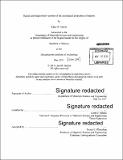Radial and longitudinal variation of the mechanical properties of bamboo
Author(s)
García, Lina M. (Lina Mariá García De la Ossa)
DownloadFull printable version (7.718Mb)
Other Contributors
Massachusetts Institute of Technology. Department of Materials Science and Engineering.
Advisor
Lorna J. Gibson.
Terms of use
Metadata
Show full item recordAbstract
Although used for millennia, only recently has there been an increased interest in bamboo as a construction material for its economic, social and environmental benefits. For bamboo to be widely implemented in construction, however, there is a need to better understand the variation in the plant's mechanical properties. The microstructure of bamboo and the mechanical properties of the solid cell wall material of bamboo were characterized for use in models for the variation of the overall mechanical properties of bamboo as a function of radial and longitudinal position. The density of bamboo and the volume fraction of vascular bundles in the bamboo increases with radial position (away from the center of the culm) and decreases with height. Tensile tests follow the trends predicted by the models. Young's modulus and strength increase with radial position (away from the center of the culm). Values for Young's modulus were in the range of 5 to 40 GPa and values for strength varied from 100 to 400 MPa.
Description
Thesis: S.B., Massachusetts Institute of Technology, Department of Materials Science and Engineering, 2011. Cataloged from PDF version of thesis. Includes bibliographical references (pages 47-48).
Date issued
2011Department
Massachusetts Institute of Technology. Department of Materials Science and EngineeringPublisher
Massachusetts Institute of Technology
Keywords
Materials Science and Engineering.